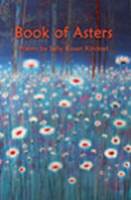|
 
Strolling the Meadows of Loss: Sally Rosen Kindred and Book of Asters
Sally Rosen Kindred
Book of Asters
Mayapple Press, © 2014
ISBN: 978-1-936419-34-0
69pp, Paper
$14.95
Into the meadow we step, this wild floral gathering Sally Rosen Kindred cultivates in her second full-length collection Book of Asters. In culling this field of poems, she astounds the reader, as though he crests a barren hill to behold an infinite spread of gold and green ululating in the breeze.
Entering the book is like wading into an overgrowth which soon swallows the reader. Her opening piece, “Common Daisy,” weaves a musical field of likenesses through rhyme and alliteration. “Take me petal, sepal, carpel. / Take me ache, thirsty eye,” Kindred writes. The verse is reminiscent of Megan Snyder-Camp’s opening poem “Sea Creatures of the Deep” in The Forest of Sure Things, as well as Melissa Stein’s piece entitled “Allergy” in her debut Rough Honey. “Common Daisy,” consisting of 11 couplets, precedes “Feathers, Sister, Falling,” containing 11 tercets, then “Confession,” a single block of 44 lines. The author subtly exercises her mastery of the physical poem as the pieces multiply in length before our eyes. She leads the reader from a thin field of flowers to a wafting feather, and, finally, a lush, impenetrable density.
One twist Kindred offers is to recognize feminist writers Charlotte Perkins Gilman and Sylvia Plath. In the poem “When They Paint the Room Yellow,” the author acknowledges the significance of Gilman’s short story “The Yellow Wallpaper,” that masterpiece detailing a woman’s oppression, claustrophobia, and abuse at the hands of her husband. The poet writes, “I want to live / in that hive: fold my body / into all their golden angles.” Plath’s references, on the other hand, are more subtle, with Kindred’s mentioning her gold baby in “Sunflowers,” a nod to Plath’s “Lady Lazarus,” and snippets reminiscent of “The Applicant” in “The Sirens Comfort Me.” (“There there.”)
As the cover insinuates, Asters depicts an ethereal, dreamlike feel. “It’s the Afterlife, Again” witnesses “empty carts cross the Winn-Dixie lot / pushed by the ghosts / of our mothers . . .”) In the next piece, “That Gray Sheet, That Song,” Kindred’s speaker transforms herself into a ghost, an empty field “where nothing grows / for long.”
The poet’s chapbook Darling Hands, Darling Tongue underscored the author’s interest in retelling fairy tales, especially utilizing a feminist lens. While Darling Hands addressed gender roles in Peter Pan, Kindred explores those roles within the modern American family throughout Book of Asters. In four poems featuring the appearance of a husband or father, music accompanies the event. “His Clarinet” and “Sabrina, Borne” signify the importance of melody in relation to father figures. In “Your Arm,” a love poem to the speaker’s husband, Kindred opens with “I call it thick music. I call it milk and bread, / your skin under my tongue under the night-blue roof . . .” These poems help propagate the idea that a man’s appearance initiates song, if only dirge. “The dead men are incidental,” she writes in “The Sirens Comfort Me.” “The song is for you, any woman / without wings.”
While Kindred’s latest volume draws comparisons to her own earlier work, Book of Asters also resembles Alice in Wonderland. Escapism permeates the collection. Children transform to flowers in “Ironweed Summer,” (“We had to be hard as those stems . . .”), “The Sirens Comfort Me” (“You lost what, a child? Not even? / A pile of soft petals unfolding . . .”), and “Goldenrod” (This one is the family entire / crowded in the sedan . . .”) The poet also touches on the tale of Rose Red in “All Afternoon,” and that mecca of American fairyland Walt Disney World in “Fireworks, Monorail, Tram, Lot, Car.”
At least 12 poems address death, miscarriage, or permanent loss. Almost from the start, the speaker muses in “Confession,” “I am sorry the worm is alive,” the worm, that corpse feeder. “[O]ur grief’s a mess,” she declares, and later explains, “[N]o death in you can be small.” Dying, loss, and permanence: all these themes are tied to the earth from which the asters spring and grow and thrive.
While many of Asters’ poems record a sense of lowering into the earth (“Confession,” “That Great Sheet, That Song,” and “Animal Griefs,” among others), Kindred appropriately closes with a rising in “Zinnia.” She observes “. . . petals launched like a girl’s / bright leg pumping up the hill / over her mother’s ghost / garden.” She defiantly declares at the volume’s end, “Bring on the binding curse, / the word zinnia in her mother’s mouth, in flight / across a season of Monarchs, a sea of sour stars.” And in this rising lies Asters’ secret. We, in the end, are not governed by death, despite the grip it exercised over us so long. And that realization liberates us from its tyranny as we move on to those waiting, those smiling and reaching down.
Works Cited
Kindred, Sally R. Book of Asters. Woodstock, NY: Mayapple Press, 2014. Print.
Kindred, Sally R. Darling Hands, Darling Tongue. Pittsburgh, PA: Hyacinth Girl Press,
2013. Print.
Plath, Sylvia. The Collected Poems. New York: Harper Collins, 1981. Print.
Snyder-Camp, Megan. The Forest of Sure Things. North Adams, MA: Tupelo Press,
2010. Print.
Stein, Melissa. Rough Honey. Philadelphia, PA: American Poetry Review, 2010. Print.
--Paul David Adkins
Paul David Adkins lives in New York and works as a counselor.
Also by Paul David Adkins:
Review of
Guinevere in Baltimore by Shelley Puhak
Review of Hurricane Party by Alison Pelegrin
|
|


